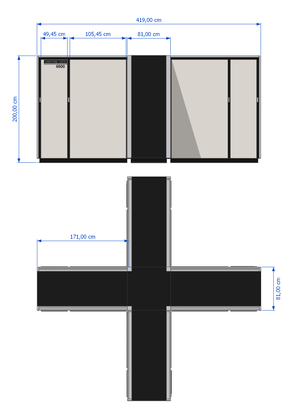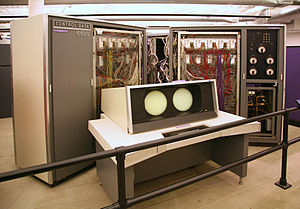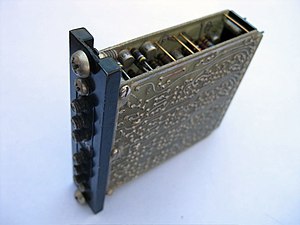CDC 6600
Management was delighted, and made plans for a new series of machines that were more tailored to business use; they would include instructions for character handling and record keeping for instance.[21] Taking his core team to new offices near the original CDC headquarters, they started to experiment with higher quality versions of the "cheap" transistors Cray had used in the 1604.Cray then decided the solution was to work with the then-new silicon-based transistors from Fairchild Semiconductor, which were just coming onto the market and offered dramatically improved switching performance.During this period, CDC grew from a startup to a large company and Cray became increasingly frustrated with what he saw as ridiculous management requirements.After a short search, Cray decided to return to his home town of Chippewa Falls, Wisconsin, where he purchased a block of land and started up a new laboratory.[when?]Although this process introduced a fairly lengthy delay in the design of his new machine, once in the new laboratory, without management interference, things started to progress quickly.The 6600 began to take form, with Cray working alongside Jim Thornton, system architect and "hidden genius" of the 6600.Then-CEO Thomas Watson Jr. wrote a memo to his employees on August 28, 1963: "Last week, Control Data ... announced the 6600 system.Contrasting this modest effort with our vast development activities, I fail to understand why we have lost our industry leadership position by letting someone else offer the world's most powerful computer."These delays set a maximum upper limit on performance, as the machine could only operate at a cycle speed that allowed the signals time to arrive at the next module.The CDC 6600 used a simplified central processor (CP) that was designed to run mathematical and logic operations as rapidly as possible, which demanded it be built as small as possible to reduce the length of wiring and the associated signalling delays.Supporting the CPU were ten 12-bit 4 KiB peripheral processors (PPs), each with access to a common pool of 12 input/output (I/O) channels, that handled input and output, as well as controlling what data were sent into central memory for processing by the CP.The 6600's CP used a 60-bit word and a ones' complement representation of integers, something that later CDC machines would use into the late 1980s, making them the last systems besides some digital signal processors to use this architecture.By allowing the CPU, peripheral processors (PPs) and I/O to operate in parallel, the design considerably improved the performance of the machine.The PPs were based on the simple 12-bit CDC 160-A, which ran much slower than the CPU, gathering up data and transmitting it as bursts into main memory at high speed via dedicated hardware.While slower in theory due to the additional memory accesses, the fact that in well-scheduled code, multiple instructions could be processing in parallel offloaded this expense.The system read and decoded instructions from memory as fast as possible, generally faster than they could be completed, and fed them off to the units for processing.The units were: Floating-point operations were given pride of place in this architecture: the CDC 6600 (and kin) stand virtually alone in being able to execute a 60-bit floating point multiplication in time comparable to that for a program branch.A user program which attempts to access memory outside the allowed range (that is, with an address which is not less than FL) will trigger an interrupt, and will be terminated by the operating system.ECS could be used for a variety of purposes, including containing user data arrays that were too large for central memory, holding often-used files, swapping, and even as a communication path in a multi-mainframe complex.To handle the "housekeeping" tasks, which in other designs were assigned to the CPU, Cray included ten other processors, based partly on his earlier[when?]These machines, called Peripheral Processors, or PPs, were full computers in their own right, but were tuned to performing I/O tasks and running the operating system.(Substantial parts of the operating system ran on the PP's; thus leaving most of the power of the Central Processor available for user programs.)When the CP program needed to perform an operating system function, it would put a request in a known location (Reference Address + 1) monitored[32] by PP0.This memory served for both for I/O buffering and program storage, but the execution units were shared by ten PPs, in a configuration called the Barrel and slot.CDC used the term "byte" to refer to 12-bit entities used by peripheral processors; characters are 6-bit, and central processor instructions are either 15 bits, or 30 bits with a signed 18-bit address field, the latter allowing for a directly addressable memory space of 128K words of central memory (converted to modern terms, with 8-bit bytes, this just under 1 MB).A complementary variant, called 6/12 display code, was also used in the Kronos and NOS timesharing systems to allow full use of the ASCII character set in a manner somewhat compatible with older software.Development timelines continued to slip, costing CDC major amounts of profit in the form of delivery delay penalties.MACE ([Greg] Mansfield And [Dave] Cahlander Executive) was written largely by a single programmer in the off-hours when machines were available.The unofficial MACE software was later chosen over the official SCOPE product as the basis of the next CDC operating system, Kronos, named after the Greek god of time.




Control Data CorporationSeymour CrayOperating systemKRONOS60-bitMemorykilobytesCDC 1604CDC 7600system consoledisplaysvector drawing systemraster systemAutocompletion6000 seriesmainframe computersupercomputerIBM 7030 StretchmegaFLOPSLivermoreLos AlamosCourant Institute of Mathematical SciencesLawrence Radiation LaboratoryComputer History MuseumMountain View, CaliforniaEngineering Research Associatestransistor-based computerstransistorsgermaniumCDC 3000 seriessiliconFairchild SemiconductorCDC 3600William NorrisChippewa Falls, WisconsinJim Thorntonnuclear weaponCDC CyberThomas Watson Jr.central processing unitinput/output (I/O) channelsinput/outputones' complementdigital signal processorsCDC 6700front panelscomplex instruction setreduced instruction set computerCDC 160-Aburstsmultithreadingregister barrelCDC 6000 seriesfunctional unitsparallelregisters18-bitsuperscalar processorarchitecturefloating pointMFLOPSFORTRANbase-boundcore dumpvirtual memorychannels12-bitBarrel and slot6-bit charactersCDC display codejob-controlChippewa Operating SystemCDC 3000Los AngelesSunnyvale, Californiatime-sharingArden Hills, MinnesotaGreek god of timesmoke testingCOMPASSAssembly languageshigh-level languageretrofittedHistory of supercomputingLawrence Berkeley LaboratoryNorman P. JouppiAssociation for Computing MachineryUNIVAC 1100/2200 seriesThornton, JamesCharles Babbage InstituteCDC 8600CDC STAR-100Gordon BellWorld's most powerful computerCDC 160 seriesCDC 1700VectorCDC Cyber 200CDC KronosNOS/VECDC SCOPECDC WrenStorage Module DevicePLATO (computer system)ETA SystemsCray Inc.